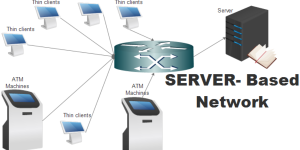Server-Based Computing
In today’s rapidly evolving digital landscape, organizations are constantly seeking innovative solutions to streamline their operations and boost productivity. One such transformative technology that has gained prominence is Server-Based Computing (SBC). This article delves into the intricacies of SBC, exploring its key concepts, benefits, and its impact on reshaping the way we approach digital tasks.
Understanding Server-Based Computing (SBC)
Server-Based Computing, at its core, involves the centralization of computing resources on a server rather than on individual devices. This paradigm shift offers numerous advantages, including improved resource management, enhanced security, and simplified maintenance. By distributing application processing tasks to a centralized server, SBC enables seamless access to software and data, fostering a more efficient digital ecosystem.
Key Components of Server-Based Computing
To grasp the full potential of SBC, it’s essential to comprehend its key components. This section elucidates the core elements, such as the server infrastructure, virtualization technologies, and thin clients, that collectively contribute to the success of server-based computing environments.
Advantages of Implementing Server-Based Computing
The adoption of SBC brings forth a plethora of benefits that can significantly impact an organization’s operational efficiency. From cost savings to heightened security measures, this section explores the advantages that make server-based computing an appealing choice for businesses of all sizes.
Cost Efficiency
SBC minimizes the need for powerful individual devices, as most processing tasks are offloaded to the server. This not only reduces hardware costs but also results in lower energy consumption, translating into substantial savings for organizations.
Centralized Management
Managing software updates, security patches, and user access becomes a streamlined process with SBC. Centralized control simplifies administration tasks, ensuring a more efficient and organized digital infrastructure.
Enhanced Security
By centralizing data and applications, SBC enhances security measures. This mitigates the risks associated with data breaches and unauthorized access, providing a robust defense against evolving cyber threats.
Implementing Server-Based Computing in Your Organization
To harness the benefits of SBC, organizations need to implement it effectively. This section provides practical insights into the steps involved in adopting server-based computing, from infrastructure considerations to user training.
Infrastructure Planning
A successful SBC implementation starts with a comprehensive infrastructure plan. This involves assessing server capacity, network requirements, and compatibility with existing systems to ensure a seamless transition.

User Training and Adoption
User acceptance plays a crucial role in the success of any technological shift. Effective training programs and clear communication about the advantages of SBC help employees adapt to the new system, fostering a positive transition experience.
Overcoming Challenges in Server-Based Computing
While SBC offers a myriad of benefits, it’s not without its challenges. This section addresses common obstacles faced during the implementation of server-based computing and provides strategies to overcome them.
Network Dependence
SBC’s reliance on network connectivity poses challenges in situations of network downtime or latency. Employing redundant networks and optimizing infrastructure can mitigate these issues and ensure a more reliable system.
Compatibility Issues
Ensuring compatibility between existing applications and the server-based computing environment is crucial. Thorough testing and collaboration with software vendors can help identify and resolve compatibility issues.
Future Trends in Server-Based Computing
As technology continues to evolve, so does the landscape of server-based computing. This final section explores emerging trends, such as edge computing integration and advancements in virtualization technologies, providing a glimpse into the future of SBC.
Edge Computing Integration
The integration of edge computing with server-based models is poised to redefine how computing resources are distributed. This trend aims to enhance performance and reduce latency by processing data closer to the source.
Virtualization Innovations
Advancements in virtualization technologies, including containerization and improved hypervisor capabilities, promise to further optimize server-based computing environments. These innovations contribute to increased flexibility and scalability.
In conclusion, server-based computing stands as a pivotal technology in reshaping digital efficiency. From its foundational concepts to practical implementation strategies and future trends, this article has provided a comprehensive exploration of SBC. Organizations keen on maximizing productivity and streamlining their digital operations should undoubtedly consider the transformative power of server-based computing.
Alborz Computers
Alborz Computers stands as a beacon of innovation in the realm of technology solutions. With a steadfast commitment to excellence, Alborz Computers continually strives to push the boundaries of possibility in the ever-evolving landscape of computing. Through a fusion of cutting-edge hardware, intuitive software, and unwavering dedication to customer satisfaction, Alborz Computers remains at the forefront of technological advancement, empowering individuals and businesses alike to unlock their full potential in the digital age.
